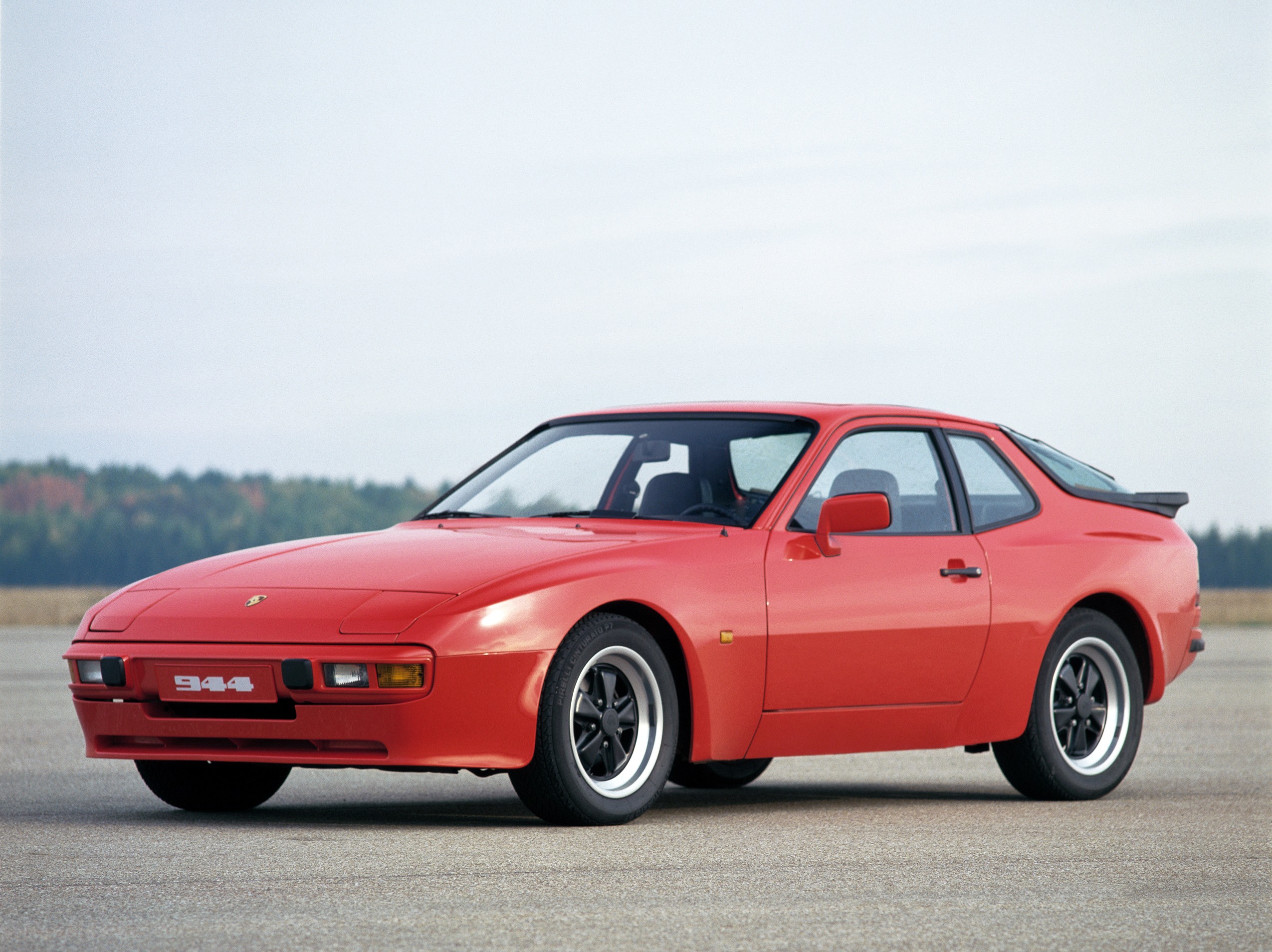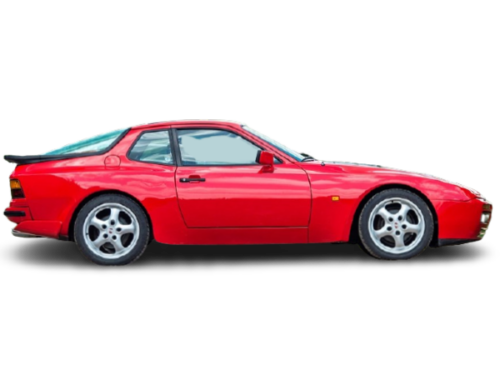(1982 – 1989) Porsche 944 Coupe – Ultimate Guide
The base Porsche 944 coupe was built between 1982 and 1989, essentially the same platform as the Porsche 924 (there was some overlap as the 924 was produced till 1988). The 944 was intended to last into the 1990s, but major revisions planned for a 944 S3 model were eventually rolled into the Porsche 968 instead, which replaced the 944.
Porsche re-worked the 924 chassis and platform and most importantly replaced the Audi engine with a true Porsche engine. It was an all new, all-alloy 2.5 litre straight-4 engine, bore 100mm, stroke 78.9mm, that was, in essence, half of the Porsche 928‘s 5.0 litre V8.
Not a natural choice for a luxury sports car, a four cylinder engine was chosen for fuel efficiency and size, because it had to be fitted from below on the Neckarsulm production line. To overcome the unbalanced secondary forces that make other four cylinder engines feel harsh, Porsche included two counter rotating balance shafts running at twice engine speed. Invented in 1904 by British engineer Frederick Lanchester, and further developed and patented in 1975 by Mitsubishi Motors, balance shafts carry eccentric weights which produce inertial forces that balance out the unbalanced secondary forces, making a four cylinder engine feel as smooth as a six cylinder.
The engine was factory-rated at 150 bhp (112 kW; 152 PS) in its U.S. configuration. Revised bodywork with wider wheel arches, similar to that of the 924 Carrera GT, a fresh interior and upgrades to the braking and suspension systems rounded out the major changes. Porsche introduced the 944 for MY 1982 to great anticipation. In addition to being slightly faster (despite having a poorer drag co-efficient than the 924), the 944 was better equipped and more refined than the 924, it had better handling and stopping power and was more comfortable to drive.
The car was decently quick for the time, with a 0 to 60 mph time of 7.8 seconds and a top speed of 130 mph. The most exciting about the car was the nearly 50/50 weight distribution (50.7% front/49.3% rear), making it a great car to drive with phenomenal balance. With predictable handling at the limits of adhesion and that strong performance, it was immediately successful and big with can fans.
Everybody knows that Porsche purchased the 924 design and finished development of the car, and while the car drove and handled exceptionally well and received positive reviews, it was criticized for the Audi-sourced 2 litre engine. With the introduction of the Porsche 944 with its Porsche engine, things were much better.
The engine itself was, in essence half of the Porsche 928’s V8 powerplant. Particular attention was given to refinement – one of the Porsche 924’s great bugbears. A breakthrough came in the form of TOP – Thermally Optimised Porsche. This was a study by the company in 1980 to find the optimum conditions for the compression ratio, air and fuel mixture, cylinder head design and ignition timing, and the 944’s 2.5 litre engine was the first Porsche engine to benefit from the research. As mentioned above, the engine mounts were changed in the name of refinement, to a softer fully synthetic material, more suited to the absorption of engine-based vibrations. Overall power output of the engine was 163BHP for the European market car, and 143BHP for the USA market car. A boast for the engine was the then-remarkable 12,000 mile service intervals.
Changes Over Time
Over its life, the base Porsche 944 had quite a few improvements.
The pre-1985 vehicles were the first 944s produced, and as such are the most basic of the entire expansive model range. Externally, the cars were supplied with electric mirrors and the rear spoiler, along with the distinctive ‘Cookie Cutter’ alloy wheel design, which could be painted with black or white centres, or just left normal silver. centered Fuchs forged alloys, as seen on the 911, were optional.
Two types of front-valance were available – one with a simple twin line grille, or one with driving lamps inset to it. A rear under-valance was optional – this was colour-coordinated to the bodywork, and featured a series of vertical slats, each covered by black-painted mesh. A major improvement over the 924 was the fitment of a flush windscreen.
Interior-wise, very few changes were made over the 924 – the square dashboard was retained, however new fabric colors and leather options were available. Interior noise was greatly reduced over the 924, mainly by adding more sound proofing but also by Porsche choosing to change the engine mounts.
In mid-1985 the 944 underwent its first significant changes. This entailed a complete revamp of the colour charts and interior options, as well as the alloy wheel design – the range-standard ‘Telephone Dial’ alloy wheel was added to the range. Minor changes to the powerplant involved changes to the material used to manufacture the exhaust valves.
The most significant change arrived in the form of a completely new interior design, dominated by a smooth, sweeping oval dashboard. This severed all ties with the 924, and completed the move upmarket for the 944. The new dash design improved ventilation and front leg room – something that was limited by the now-dated square dash design. The dash provided improved ergonomics for the instruments, with all useful components placed either above the gearstick or on the strip running across the dash, moving the buttons to within an arm’s stretch from the driver.
For 1986, the ‘Lux’ coupe was thrown out of the limelight by the new 944 Turbo – a ‘wonderfully refined product’ as period press branded it. The Turbo featured a 220BHP 2.5 litre four-cylinder engine, essentially a turbocharged standard unit but with strengthened internals to cope with the onslaught of power. Other major differences over the 944 coupe was the clean, smooth bumpered look at the front end, larger brakes, wider ‘Telephone Dial’ alloys and a price which was identical to that of a 911 Carrera. Although the car was a super performer (0-62mph in 5.5 secs), the buyers stayed away – mainly due to the the fact that the ‘superior’ 911 was the same price. Included in that price were masses of standard equipment, Recaro designed sports seats, a new, four spoke ‘Lozenge’ steering wheel. The model also brought revised doorcards and a distinctive rear underspoiler to the fray.
Later in 1986, the 944 S arrived, updating the 944 range with a 16-valve 2.5 litre engine. It’s performance specs placed it right in between the 8 valved models, NA and turbo’ed respectively. It provided a smoother delivery of it’s power then the Turbo , which could be a handful at the moment where boost would kick in.
A 2.7 litre 8 valve engine (a bored-out 2.5) was offered to European markets only, it retained the same horse power as the 2.5, but had slightly increased torque. There were some reports that this 2.7 initially had some reliability issues, and as it was least produced of all naturally aspirated 8 valve engines, the unique engine parts, such as the cyllinderhead are more sought after and as such more expensive.
But the 944 was beginning to face the same fate as its predecessor – Porsche had not advanced to model quick enough to keep up with competition, and the car was very expensive for what it was, Porsche or not. Sales began to fall in 1987, and even with some sparkling limited editions in various markets, along with the new 8v 2.7 engine, the slide proved unstoppable for the 944. For the 1987 model year, the 944 was updated to incorporate anti-lock braking and air bags for increased safety. Because of the ABS system, the wheel offset changed and Fuchs wheels were no longer an option.












